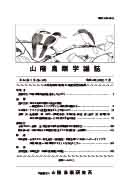Volume 54, Issue 1
Displaying 1-15 of 15 articles from this issue
- |<
- <
- 1
- >
- >|
Special issue of 90th Anniversary of the Yamashina Institute for Ornithology Foundation
Preface
-
2022Volume 54Issue 1 Pages 1
Published: July 02, 2022
Released on J-STAGE: July 12, 2022
Download PDF (151K)
Reviews
-
2022Volume 54Issue 1 Pages 3-53
Published: July 02, 2022
Released on J-STAGE: July 12, 2022
Download PDF (891K) -
2022Volume 54Issue 1 Pages 55-70
Published: July 02, 2022
Released on J-STAGE: July 12, 2022
Download PDF (4534K) -
2022Volume 54Issue 1 Pages 71-102
Published: July 02, 2022
Released on J-STAGE: July 12, 2022
Download PDF (2679K)
Original Articles
-
2022Volume 54Issue 1 Pages 103-139
Published: July 02, 2022
Released on J-STAGE: July 12, 2022
Download PDF (31254K) -
2022Volume 54Issue 1 Pages 141-164
Published: July 02, 2022
Released on J-STAGE: July 12, 2022
Download PDF (11638K)
Perspective
-
2022Volume 54Issue 1 Pages 165-181
Published: July 02, 2022
Released on J-STAGE: July 12, 2022
Download PDF (871K)
Miscellanea
-
2022Volume 54Issue 1 Pages 182-186
Published: July 02, 2022
Released on J-STAGE: July 12, 2022
Download PDF (363K)
Original Article
-
2022Volume 54Issue 1 Pages 187-192
Published: July 02, 2022
Released on J-STAGE: July 12, 2022
Download PDF (341K)
Short Notes
-
2022Volume 54Issue 1 Pages 193-200
Published: July 02, 2022
Released on J-STAGE: July 12, 2022
Download PDF (448K) -
2022Volume 54Issue 1 Pages 201-206
Published: July 02, 2022
Released on J-STAGE: July 12, 2022
Download PDF (1258K)
Letter
-
2022Volume 54Issue 1 Pages 207-214
Published: July 02, 2022
Released on J-STAGE: July 12, 2022
Download PDF (694K)
Report
-
2022Volume 54Issue 1 Pages 215-218
Published: July 02, 2022
Released on J-STAGE: July 12, 2022
Download PDF (324K)
Materials
-
2022Volume 54Issue 1 Pages 219-222
Published: July 02, 2022
Released on J-STAGE: July 12, 2022
Download PDF (4750K) -
2022Volume 54Issue 1 Pages 223-225
Published: July 02, 2022
Released on J-STAGE: July 12, 2022
Download PDF (4716K)
- |<
- <
- 1
- >
- >|
